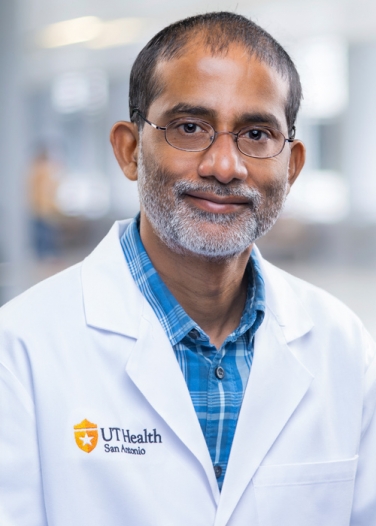
Programs
Departments & Divisions
Institutes & Centers
Research Areas
CancerSandeep Burma, PhD, FNASc
Professor, Vice Chair (Research), Mays Family Foundation Distinguished Chair in Oncology
Currently seeking M.S. & Ph.D. students
Research in the Burma Laboratory is focused on the responses of mammalian cells to DNA double-strand breaks (DSBs), collectively called the DNA damage response (DDR). We are involved in studying DDR events triggered by ionizing radiation and their carcinogenic and cancer therapeutic implications. We are particularly interested in 1) understanding DSB signaling and repair mechanisms with a focus on the regulation of DNA end resection by EXO1, 2) genetic basis of radio- and chemo-resistance of glioblastomas (GBM), with the translational objective of targeting DNA repair pathways for GBM therapy, 3) genetic changes underlying gliomagenesis triggered by ionizing radiation, the only known risk factor for the development of GBM, and 4) radiation-induced senescence as a driver of glioblastoma recurrence, with the clinical objective of blunting recurrence using senolytic approaches. A more mechanistic understanding of DDR events has emerged from our studies, providing important insights into how GBM is triggered, and leading to the development of better therapeutic approaches for GBM.
-
Professional Background
Education
- 1995 - Ph.D. - Molecular Biology - National Institute of Immunology, India
- 1990 - M.Sc. - Zoology (Specialization in Molecular Genetics and Cytogenetics) - Banaras Hindu University, India
- 1988 - B.Sc - Botany, Zoology, Chemistry (Honors in Zoology) - Banaras Hindu University, India
Training
- 1999 - Postdoctoral Associate - DNA Repair - Life Sciences Division, Los Alamos National Laboratory
- 1998 - Postdoctoral Associate - Transcription Regulation - Dept. of Biochemistry & Mol. Biology, Pennsylvania State University
- 1996 - Postdoctoral Associate - Transcription Regulation - Dept. of Mol. Biophysics & Biochemistry, Yale University
Highlights
2003 Concept Award, DOD, USA
2009 Fellowship for lecture-tour of Japan, JSPS, Japan
2017 Visiting Professor, Mayo Clinic, AZ
2018 Keynote Speaker, Indo-US Conference on Genomic Instability, India
2019 Keynote Speaker, 65th International Congress of Genetics, Brazil
2019 Award for Excellence in Adult Basic Science, Society for Neuro-Oncology, USA
2022 Co-chair, 2022 Texas Genome Stability Conference, TX
2022 Elected Foreign Fellow (FNASc), National Academy of Sciences, India
Appointments
- 1991-2005 - Scientist Biologist - Lawrence Berkeley National Laboratory, Berkeley, CA
- 2005-2012 - Assistant Professor - Radiation Oncology, UT Southwestern Medical Center, Dallas, TX
- 2012-2019 - Associate Professor - Radiation Oncology, UT Southwestern Medical Center, Dallas, TX
- 2019-date - Professor, - Neurosurgery and Biochemistry & Structural Biology, UT Health San Antonio, TX
- 2019-date - Vice Chair (Research) - Dept. of Neurosurgery, UT Health San Antonio, TX
- 2019-date - Mays Family Foundation Distinguished Chair in Oncology - Mays Cancer Center at UT Health San Antonio MD Anderson, TX
- 2023-date - Co-Leader - Cancer Development Program, Mays Cancer Center at UT Health San Antonio
-
Research & Grants
The Burma laboratory works on mechanisms of DNA double-strand break repair in mammalian cells. We also use some of the knowledge gleaned from these studies to develop novel therapeutic approaches to treat glioblastoma. The research projects are structured such that basic results (from project 1) could be used to devise translational strategies to improve radiotherapy of glioblastoma (project 2), and to understand how radiation can also paradoxically trigger these lethal brain tumors or drive recurrence (projects 3 and 4).
-
Service
Service to the Profession
2015-date Guest Associate Editor, PLOS Genetics
2020 Associate Editor, Key Leaders’ Opinion of Precision Radiation Oncology
2018 - date Member, Editorial Board of DNA Repair
2020-date Member, Editorial Board of Journal of Biological Chemistry
2018-date Member, Editorial Board of Annals in Translational Medicine
2015-date Member, Scientific Advisory Committee (SACCR), NASA Space Radiation Laboratory
2011-date Reviewer, NIH (MONC, MGB and RTB), DOD, NASA, and AACR grant review panels
2005–date Regular Reviewer for Cell, Science, Nature, EMBO, and AACR journals among others
-
Publications
Related media
- Burma Lab
- WQAD-TV, Your Health: Protecting astronauts from deep space radiation
- WAFB-TV, Glioblastoma: Stopping It from Returning
- New research led by Mays Cancer Center reveals how mutations in BRCA1 affect cancer susceptibility in women
- Glioblastoma recurrence and clues to blunt it
- When it comes to DNA repair, it’s not one tool fits all
- The Biology of Cancer
- Dr. Burma honored by Society for NeuroOncology